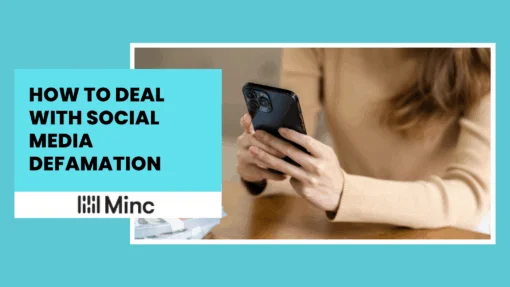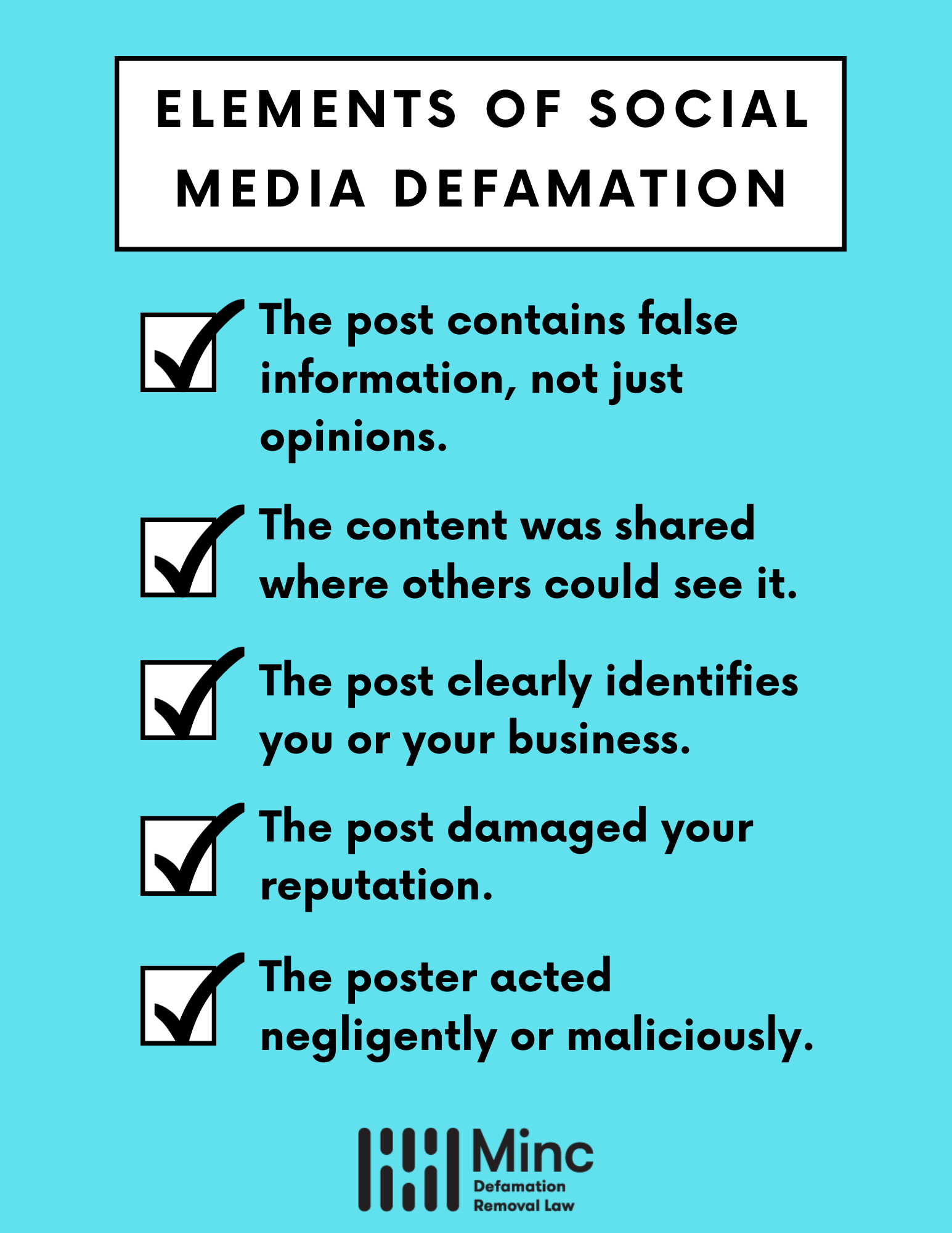
- Originally Published on May 13, 2025
How to Deal With Social Media Defamation, Libel & Slander
Have you discovered a false statement about you or your business on social media that is damaging your reputation? You are not alone, and you have options.
As attorneys who have helped hundreds of clients fight back against online defamation, Minc Law understands both the legal challenges and emotional toll these situations create. This guide will walk you through exactly what qualifies as social media defamation, how to document evidence before it disappears, and the specific steps you can take to protect your reputation and seek removal of harmful content.
Social media defamation occurs when someone publishes false statements of fact on platforms like Facebook, X, or Instagram that damage another person’s or business’s reputation. To be legally actionable, the statement must be: (1) demonstrably false, (2) published to third parties, (3) harmful to reputation, and (4) made with at least negligence.
Can You Sue For Defamation on Social Media?
To qualify as defamation on social media, a statement must meet specific legal requirements. Understanding these elements is crucial for determining whether you have a valid legal claim.
False Statement of Fact
The foundation of any defamation claim is falsity. The statement in question must be presented as fact, not opinion, and must be demonstrably false.
Opinions, by contrast, are subjective evaluations that cannot be proven false. Statements like “I think he is a terrible doctor” or “In my view, their customer service is awful” generally constitute protected opinions.
Publication to Third Parties
For defamation to occur, the false statement must be communicated to at least one person other than yourself and the publisher. On social media, this requirement is typically easily satisfied.
The “publication” element includes public posts visible to followers, posts in private groups with multiple members, direct messages sent to multiple recipients, and comments on posts that others can view. Even resharing defamatory content originally posted by someone else counts as publication.
Even if a post has limited visibility, it still meets the publication requirement if anyone beyond you and the defamer can see it.
Identification of the Subject
The defamatory statement must clearly identify you or your business, either directly or by implication.
Direct identification could include using your full name, tagging your profile, posting on your page, or using your business name. Implied identification can include using a nickname recognizable to others, describing unique characteristics that make you identifiable, or referring to your position or role.
If a reasonable person who knows you would understand that the statement refers to you, the identification requirement is typically satisfied.
Harm to Reputation
The false statement must cause actual damage to your reputation. This harm can take various forms including professional damage, social harm, emotional distress, or financial losses directly attributable to the defamation.
Some statements are considered “defamation per se,” meaning they are presumed harmful without requiring proof of specific damages. These typically include false accusations of criminal conduct, professional incompetence, having a loathsome disease, or sexual impropriety.
Fault Requirement
The level of fault required depends on whether you are a public or private figure.
Private individuals must prove the publisher acted with negligence, meaning they failed to exercise reasonable care in determining whether the statement was true before publishing it.
Public figures must prove “actual malice,” meaning the publisher knew the statement was false or acted with reckless disregard for its truth or falsity. This higher standard applies to government officials, celebrities, and people who have thrust themselves into public controversies.
Infographic: Elements of Social Media Defamation

How Does Social Media Defamation Differ from Traditional Defamation?
Social media defamation presents unique challenges compared to traditional formats. Unlike limited regional audiences in traditional media, social posts can reach millions globally within hours through viral sharing.
Digital content exists in a paradoxical state, potentially archived permanently yet capable of instant deletion, creating documentation and mitigation challenges. People who post defamatory content often hide behind fake names or temporary accounts, complicating legal responses.
Legal protection under the Communications Decency Act Section 230 shields social media platforms from liability for user content, requiring action against individual publishers rather than the platforms themselves. Cases frequently span multiple legal jurisdictions, affecting which courts have authority and which laws apply.
Common Examples of Social Media Defamation
The most frequent types of social media defamation include:
- False Criminal Accusations: Posts falsely claiming someone committed crimes like theft, fraud, or assault. These accusations can immediately damage relationships and careers, even without any evidence or charges.
- Professional Misconduct Claims: Made-up stories about someone’s workplace behavior, such as claiming a doctor performed unnecessary procedures or a teacher behaved inappropriately with students.
- Manipulated Evidence: Fake “proof” created by editing screenshots of conversations, altering photos, or sharing video clips that remove important context. These can be particularly damaging because they appear to offer evidence for false claims.
- Business Falsehoods: Posts that go beyond negative opinions to make specific false claims, such as “this restaurant failed health inspections” or “this company refuses to issue refunds” when these statements are untrue.
- Identity Impersonation: Creating fake profiles pretending to be someone else, then posting offensive content or false statements in their name. This damages the person’s reputation while making it appear they’re responsible for the harmful content.
- Revenge Publishing: Former romantic partners, employees, or business associates posting false information out of anger or revenge. These cases often involve particularly persistent attacks across multiple platforms.
High-Profile Examples of Social Media Defamation Cases
Several notable cases illustrate how social media defamation plays out in both celebrity and everyday contexts, with varying outcomes that highlight the complexity of these cases.
Elon Musk vs. Vernon Unsworth
In 2018, Tesla founder Elon Musk tweeted about British cave diver Vernon Unsworth, who had helped rescue 12 Thai teenagers from a flooded cave. After Unsworth criticized Musk’s offer of a mini-submarine to assist the rescue, Musk referred to him as a “pedo guy” on Twitter.
Unsworth filed a defamation lawsuit in California based on Musk’s tweets. Despite the seemingly clear accusation, the jury found that Musk’s statements did not meet the legal standard for defamation. Musk was not held liable because the jury determined that “people that read Musk’s tweet wouldn’t have known who he was talking about.”
This case demonstrates how context and identification requirements can significantly impact defamation cases, even when the statements appear obviously defamatory.
Alex Jones and Sandy Hook Families
In a landmark case with far-reaching implications, conspiracy theorist Alex Jones was held liable for repeatedly claiming on his InfoWars platform that the Sandy Hook Elementary School shooting was a “hoax” and that the parents of murdered children were “crisis actors.”
Multiple families sued Jones for defamation, and courts in both Texas and Connecticut found him liable. In 2022, juries awarded the families nearly $1.5 billion in damages collectively.
This case illustrates the severe consequences possible when defamation involves particularly egregious false statements that cause profound emotional harm, especially to private individuals who have not sought the public spotlight.
Depp v. Heard
The highly publicized defamation trial between Johnny Depp and Amber Heard centered on a 2018 Washington Post op-ed in which Heard described herself as a “public figure representing domestic abuse” without explicitly naming Depp.
Depp sued for $50 million, claiming the implication was clear and damaged his career. After a televised trial that featured extensive social media commentary and viral moments, the jury found that Heard had defamed Depp and awarded him $15 million (later reduced to $10.35 million due to Virginia’s cap on punitive damages).
How to Document Social Media Defamation Before It Disappears
Proper documentation is critical when addressing social media defamation. Without adequate evidence preservation, you may lose your ability to prove the defamation occurred at all.
Comprehensive Documentation
Screenshots provide the most basic form of evidence, but must be taken properly to be effective.
Capture the entire defamatory post with full text visible, the URL in the browser address bar, the date and time of capture, the name and profile picture of the poster, and any visible engagement metrics like likes, shares, or comments.
Capture the full browser window, not just the post itself. Take multiple screenshots if the content requires scrolling. Document the path to find the content, such as group name or page.
Platform-Specific Archiving Methods
Each social media platform offers different tools for preserving content.
On Facebook, use the “Save post” feature and the “Download Your Information” tool for a more complete record. For Twitter, use the bookmark feature and consider third-party archiving tools for longer threads. On Instagram, save posts using the bookmark icon and screen record Stories before they expire.
LinkedIn offers a “Save” feature for posts, and you can export connections if the defamer is in your network. For TikTok, use the “Favorite” function to save videos and screen record with comments visible.
Metadata Preservation and Witness Statements
Beyond the visible content, preserving associated metadata can strengthen your evidence. Save HTML source code, email notifications from the platform, direct message conversations referencing the content, and search engine results showing how the content appears.
Consider obtaining formal statements from people who viewed the defamatory content, individuals who can attest to its falsity, or witnesses to any real-world consequences. These statements should be detailed, dated, and, if possible, notarized.
An attorney can help ensure all evidence is properly collected and preserved in a way that will be most effective for your case.
Immediate Steps to Take If You Are Defamed on Social Media
Discovering defamatory content about yourself or your business requires prompt, strategic action. Following these steps in the correct order maximizes your chances of an effective resolution.
1. Document Everything First
Evidence may disappear quickly, either through deletion by the poster or platform removal. Documentation should be your absolute first priority.
2. Avoid Public Responses
Resist the urge to respond publicly to the defamation, no matter how tempting. Public exchanges can increase visibility of the false claims through algorithm amplification and create additional content that may be harder to remove later.
If you feel compelled to address the situation publicly, consult with an attorney first to ensure your response does not compromise potential legal remedies.
3. Do Not Contact the Poster Directly
Direct contact with the defamer often backfires by alerting them to potential legal action, prompting them to delete evidence before you can properly document it. It might provide them with information they can use against you or trigger additional defamatory posts.
Direct communication might create a record that could be taken out of context and escalate emotional tensions in an already volatile situation.
Any communication with the defamer should typically occur through legal channels after consulting with an attorney.
4. Report to the Platform (With Strategic Caution)
Consider reporting the content to the platform, but understand the potential implications. Platforms have varying standards for removal. Content might be removed before you have fully documented it.
If you decide to report, be specific about which platform policies the content violates. Many platforms have policies against harassment, false information, impersonation, privacy violations, and hate speech.
Frame your report in terms of these specific violations rather than using general terms like “defamation.”
5. Consult with an Experienced Internet Defamation Attorney
An experienced internet defamation attorney can evaluate the legal strength of your case, advise on jurisdiction issues, develop a strategic response plan, and help preserve evidence properly.
They can guide platform reporting for best results, draft effective cease and desist communications, and prepare for potential litigation if necessary. Many defamation victims find that a single well-crafted legal letter can resolve the situation without costly court proceedings.
Look for attorneys with specific experience in digital defamation cases, as they require specialized knowledge of both defamation law and internet platforms.
When and How to Report Defamatory Content to Social Media Platforms
Each platform has specific procedures for reporting potentially defamatory content. Understanding these processes can improve your chances of successful content removal.
Facebook Reporting Procedures
Click the three dots on the upper right of the post, select “Find support or report post,” choose “False information” and then “Defamation,” and provide requested details about why the content is false. You can submit additional evidence through the Facebook Help Center if available. You can also use their Defamation Reporting Form.
Facebook typically responds within 1-7 days but often rejects defamation claims without court orders. Success rates improve when reports focus on specific policy violations beyond defamation, such as harassment or privacy violations.
Be specific about exactly which statements are false and explain briefly how you can prove the falsity. Note any harassment or threatening elements and reference specific Facebook Community Standards violations.
X/Twitter Reporting Procedures
Click the three dots on the tweet, select “Report Tweet,” choose “It is misleading” or “It is abusive or harmful,” and follow the prompts to specify the nature of the false information.
X (formerly Twitter) rarely removes content solely based on defamation claims without legal documentation. Reports citing specific violations of X’s Rules regarding harassment or privacy have higher success rates.
Focus on specific X Rules violations and document if the tweet is part of a pattern of harassment. Note any private information being shared without consent and highlight any manipulated media or impersonation.
Instagram and LinkedIn Reporting
Instagram and LinkedIn have similar reporting procedures. For Instagram, tap the three dots above the post, select “Report,” choose “It is inappropriate,” and then “False information,” and provide details about the false claims.
For LinkedIn, click the three dots on the post, select “Report this post,” choose “Harassment or hate speech” or “Scams, fraud, or misleading content,” and provide specific details about the false information.
Both platforms typically require legal documentation for defamation removals, though LinkedIn tends to be more responsive to professional reputation concerns.
If the Platform Refuses Removal
If your report is unsuccessful, request a review of the decision if the option is available and submit additional evidence if you have obtained more documentation.
Consider whether a more formal legal approach is necessary and consult with an attorney about a cease and desist letter or retraction demand to the individual poster. Explore whether a court order might be required for content removal.
Evaluate alternative strategies, such as contacting the defamer directly through legal channels or pursuing de-indexing from search engines if platform removal fails.
Legal Options for Social Media Defamation
When platform reporting proves insufficient, several legal remedies exist.
Cease and Desist Letters
A well-crafted cease and desist letter from an attorney can be effective when the defamer’s identity is known and you want a quick resolution without court proceedings.
Effective cease and desist letters typically include specific identification of the defamatory statements, clear explanation of why the statements are false, documentation of the harm caused, specific demands for removal or retraction, a deadline for compliance, and consequences for non-compliance.
Subpoenas to Identify Anonymous Defamers
When dealing with anonymous defamation, you may need to file a “John Doe” lawsuit against the unknown defamer, obtain a court order for the platform to reveal identifying information, and then amend the lawsuit once the defamer is identified.
This process requires specific legal expertise as platforms often resist these subpoenas and courts apply varying standards for unmasking anonymous speakers.
Defamation Lawsuits
A formal defamation lawsuit may be necessary when the defamer refuses to remove content, significant damages have occurred, you need a court order for content removal, or you seek financial compensation for harm.
The typical timeline for defamation lawsuits ranges from several months to over a year, depending on complexity and jurisdiction. Potential outcomes include court-ordered content removal, monetary damages, public retraction, or injunction against future defamation.
Content Removal and De-indexing Strategies
Even without the defamer’s cooperation, options exist for directing platforms to remove content, de-indexing requests requiring search engines to remove links, right to be forgotten requests (particularly effective in the EU), and strategic content suppression through reputation management.
Taking Control When Facing Social Media Defamation
Social media defamation can feel overwhelming, but you do not have to face it alone. By understanding what legally qualifies as defamation, properly documenting evidence, and knowing your reporting and legal options, you can take effective action to protect your reputation.
At Minc Law, we have helped hundreds of clients successfully address social media defamation through platform reporting, content removal, de-indexing, and when necessary, legal action against defamers. The key is acting quickly and strategically with proper guidance.
If you are dealing with social media defamation, contact our experienced defamation attorneys for a confidential consultation to discuss your specific situation and develop an effective response plan. You can reach out by calling us at 216-373-7706 or by filling out the form below.
Get Your Free Case Review
Fill out the form below, and our team will review your information to discuss the best options for your situation.
This page has been peer-reviewed, fact-checked, and edited by qualified attorneys to ensure substantive accuracy and coverage.




